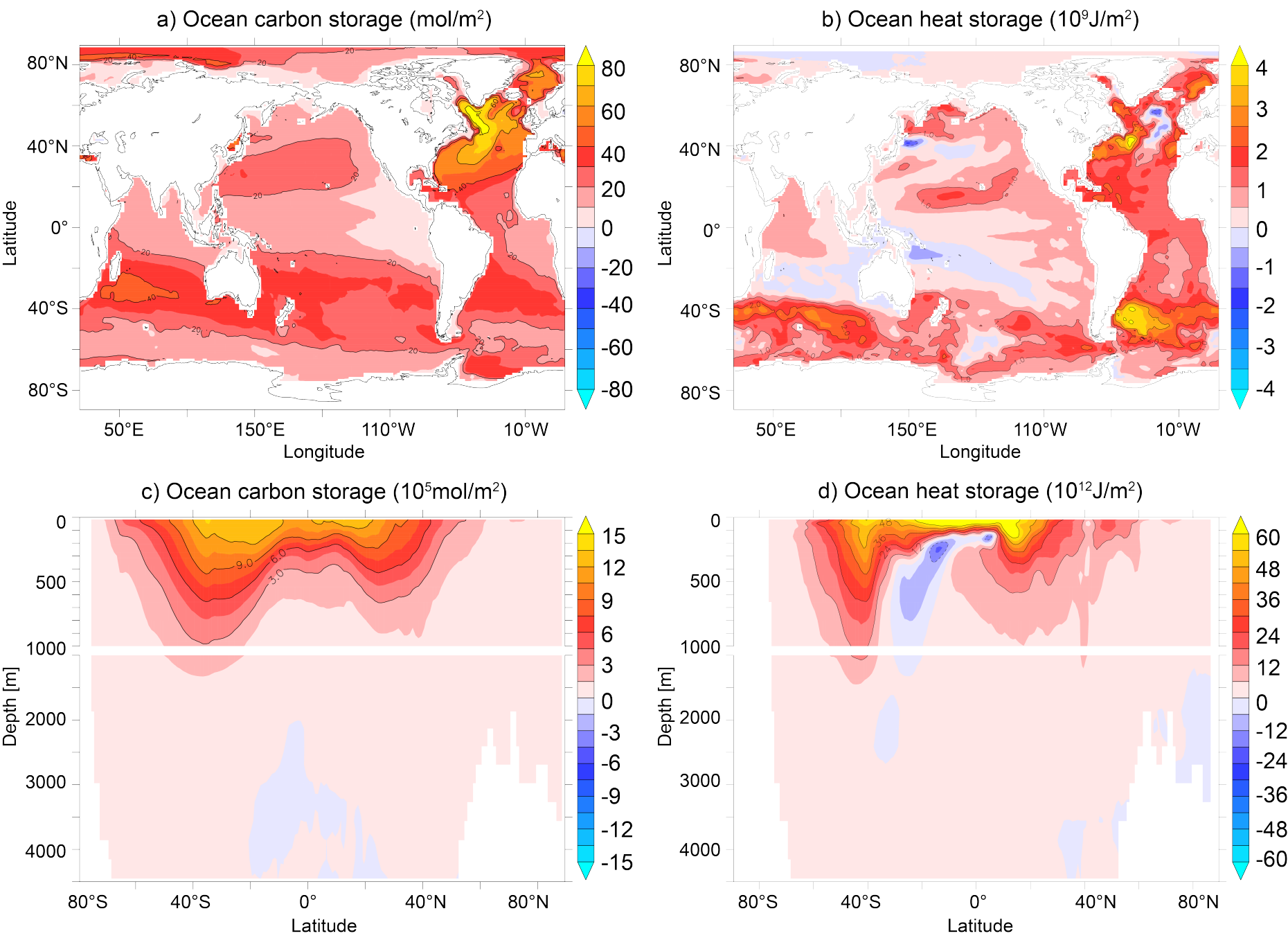Biogeochemistry and Climate Change
Thomas Frölicher (SNF Ambizione Fellow)
Working at the interface between ocean dynamics, marine biogeochemistry and climate, my research seeks to understand the role of the ocean in nutrient and carbon cycling and ultimately climate. My work combines observations and theoretical aspects with running comprehensive climate models, such as the external pageGFDL ESM2Mcall_made and the external pageNCAR CESMcall_made. One example of my current projects is summarized below. A detailed description of my specific research interests and projects can be found under external pagewww.tfroelicher.comcall_made.
What processes control ocean heat and carbon uptake, and ultimately transient climate change?
Heat and carbon dioxide (CO2) exchange between the atmosphere and ocean is a major control on Earth’s climate and increasing atmospheric CO2 and concomitant global warming stimulate uptake of both heat and CO2 by the ocean. The Southern Ocean south of 30°S, occupying just 30% of the surface ocean area, accounts for a disproportionate share of the vertical exchange of properties between the deep and surface waters of the ocean and between the surface ocean and the atmosphere (Morrison et al. 2015). Recent analysis on a new set of model simulations suggests that the Southern Ocean accounts for 75% of excess heat and 40% of anthropogenic carbon uptake since preindustrial (Frölicher et al. 2015). We also show that ocean heat uptake occurring at subpolar latitudes has a stronger cooling effect on global atmospheric surface temperature than ocean heat uptake occurring in low latitudes (Winton et al. 2013, Frölicher et al. 2014), because perturbations at high latitudes are restored less strongly by radiation to space than those at lower latitudes.
The exact processes governing the magnitude and regional distribution of heat and carbon uptake, however, remain poorly understood. Recent analyses show that oceanic storage of anthropogenic carbon and heat have distinct patterns (Fig. 1), which is not consistent with the view of passive processes acting on both anthropogenic carbon and heat (Frölicher et al. 2014). Especially in the Southern Ocean, current climate models largely differ in their representation of anthropogenic CO2 and particular heat uptake. This lack of understanding is of particular concern because (i) the ocean heat and carbon uptake similarity underpins the concept of transient climate response to cumulative carbon emissions, which suggests that the transient global warming is nearly proportional to cumulative carbon emissions on multi-decadal to millennial timescale (Frölicher et al. 2014), and (ii) ocean heat redistributions are thought to play an important role during decadal deviations in global mean surface air temperature from the long-term trend, such as the current global warming hiatus period (Von Känel 2015).
A major goal of my current and future research is to develop a conceptual framework to quantify what processes ultimately determine the differences in uptake, transport and storage of anthropogenic carbon and heat.

Key publications:
Frölicher, T. L., J. L. Sarmiento, D. J. Paynter, J. P. Dunne, J. P. Krasting, M. Winton, 2015, Dominance of the Southern Ocean in anthropogenic carbon and heat uptake in CMIP5 models. J. Climate, 28, 862-886.
Frölicher, T. L., M. Winton, J. L. Sarmiento, 2014, Continued global warming after CO2 emissions stoppage. Nature Climate Change, 4, 40-44.
Morrison, A. K., T. L. Frölicher, J. L. Sarmiento, 2015, Upwelling in the Southern Ocean, Physics Today, 68(1), 27-32.
Von Känel, 2015, Analysis of global warming hiatus periods caused by Internal Variability in a large Earth System Model Ensemble.Master Thesis, ETH Zürich.
Winton, M., S. M. Griffies, B. Samuels, J. L. Sarmiento, T. L. Frölicher, 2013, Connecting changing ocean circulation with changing climate. J. Climate, 26, 2268-2278.

